Stainless steel cookware and surfaces are known for their durability, sleek appearance, and resistance to rust. However, anyone who has cooked with stainless steel pans knows they can be sticky and tricky to clean. That’s where ceramic coatings come in. Applying a ceramic coating to stainless steel not only enhances its non-stick performance but also makes cleaning easier, extends its lifespan, and adds a layer of protection against scratches and stains.
Whether you’re looking to upgrade your stainless steel cookware, protect kitchen appliances, or even coat stainless steel car parts for extra shine and resistance, choosing the right ceramic coating is essential. With so many products available, each promising durability and high performance, it’s important to understand which ones truly deliver the best results.
Buying Guide: How to Choose the Best Ceramic Coating for Stainless Steel
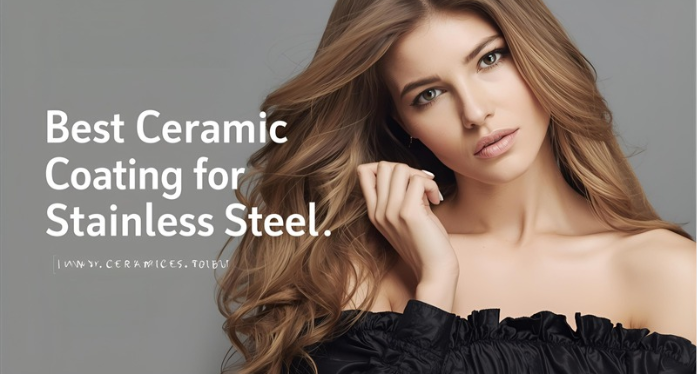
When selecting a ceramic coating for stainless steel, keep these key factors in mind:
1. Purpose of Use
- Cookware: Look for food-safe, non-toxic ceramic coatings designed for high heat and frequent washing.
- Appliances & Home Surfaces: Choose easy-to-apply sprays that resist fingerprints, stains, and smudges.
- Automotive/Industrial Use: Select heavy-duty ceramic coatings designed for corrosion resistance and long-term durability.
2. Food Safety
For cookware and kitchen use, ensure the ceramic coating is PTFE-, PFOA-, lead-, and cadmium-free. This guarantees safe cooking without harmful chemicals leaching into food.
3. Heat Resistance
Cooking surfaces demand coatings that can withstand high temperatures (up to 800°F or more) without breaking down, peeling, or releasing toxins.
4. Ease of Application
Some coatings are professional-grade and require curing or specialized equipment, while others are user-friendly sprays you can apply at home. Choose one that matches your skill and needs.
5. Durability
Look for coatings that provide scratch resistance, stain resistance, and long-lasting performance. For cookware, durability means maintaining non-stick properties even after repeated use and washing.
6. Finish and Appearance
A high-quality ceramic coating should enhance the shine and smoothness of stainless steel, giving it a polished, modern look.
7. Cleaning & Maintenance
Pick coatings that make cleanup simple. Non-stick ceramic finishes prevent food from sticking, while appliance-friendly sprays help resist smudges and fingerprints.
8. Brand Reputation & Reviews
Always consider coatings from reputable brands with positive customer feedback. Real-world reviews reveal how well a product performs beyond its claims.
✨ With the right ceramic coating, your stainless steel cookware, appliances, or even auto parts can look better, last longer, and perform more efficiently.
1. Surface Lock Home Ceramic Coating for Stainless Steel (Berkland Goods, 8 oz Spray)
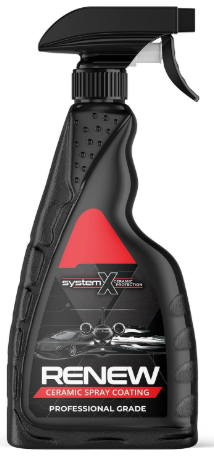
Description:
This is a ceramic spray coating designed to protect stainless steel surfaces around the home—appliances, counters, sinks, etc.—from fingerprints, stains, smudges, and water spots. It forms a hydrophobic seal (“water-repellent layer”) and promises a “silky smooth finish” that reduces the need for frequent cleaning. It’s made in the USA and marketed as safe, easy to apply, and fairly long-lasting.
Key Features:
- Hydrophobic, anti-fingerprint / anti-smudge ceramic coating spray.
- Works on stainless steel, countertops, and “any hard surface.”
- Claims that the surface seal activates quickly (with seconds to buff in) and stays effective for months.
- Spray form, which allows easy application.
Pros:
- Significantly reduces visible fingerprints and smears, which is one of the biggest complaints with stainless steel.
- Easier cleaning: with this coating, wiping down is more effective; less elbow grease.
- Affordable and decent size (8 oz) for multiple applications.
- Safe for use around food prep surfaces (though you’ll often want to ensure your cleaner is food safe or rinse well).
Cons:
- Durability depends heavily on how well the surface was prepared (cleaned) before treatment. If grease or residue remain, coating may peel or not bond well.
- The “months of effectiveness” can be optimistic — in high-traffic or frequent-touch surfaces, the coating may wear off sooner.
- Doesn’t protect against deep scratches, dents, or harsh abrasives.
Recommendation:
Good pick if you want to maintain the look of your stainless steel appliances or surfaces (fridge, dishwasher, range hood) with less frequent fingerprint cleaning. If you use your kitchen heavily, expect to reapply perhaps twice a year. For surfaces that get heavy abrasion or heat exposure, supplement this with gentle care and non-abrasive cleaners.
2. Lifeproof Home Ceramic Coating Spray Kit – Shine, Seal & Protect (Multi-Surface)
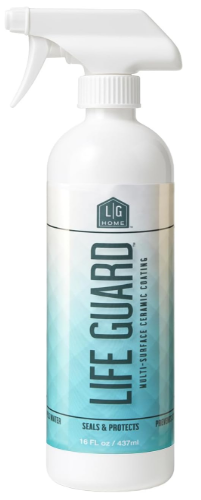
Description:
The Lifeproof Home kit is a spray-on ceramic coating aimed at multiple surfaces including stainless steel, glass, stone, tile, and more. It repels stains, fingerprints, water spots, and grime, making cleanup easier. It advertises 6-12 months of protection. It comes with a microfiber cloth and instructions for prepping, applying, and curing.
Key Features:
- Multi-surface safe: stainless steel appliances and other home surfaces.
- Highly hydrophobic / slick finish to repel liquids and stains.
- Non-toxic formula; tested for cytotoxicity.
- Spray kit includes application accessories.
- Approximately 6-12 months of expected protection under typical usage.
Pros:
- Very good longevity if applied well and maintained.
- Versatility: useful for many hard surfaces — one product can cover multiple items.
- Boosts shine; improves surface aesthetics.
- Easy “spray, buff, wipe” application is easy for non-DIY experts.
Cons:
- Needs thorough surface prep. Any oil, grease, or residual cleaners reduce effectiveness.
- Cure times mean you need to avoid getting the surface wet for a period (often a few hours). If you use the coated surface before curing, performance and durability suffer.
- The slickness can mean that items or drips may slide off or move more easily — may be undesirable in certain cases.
Recommendation:
Great if you want a “set it and forget it” type solution for countertops, backsplashes, stainless steel appliances that you touch often. Excellent for busy households who want less frequent deep cleaning. Less ideal if you often scrub hard or use abrasive tools — then the coating may wear faster.
3. MCTRHG Ceramic Coating for Stainless Steel Appliances, Gloss & Shine Spray
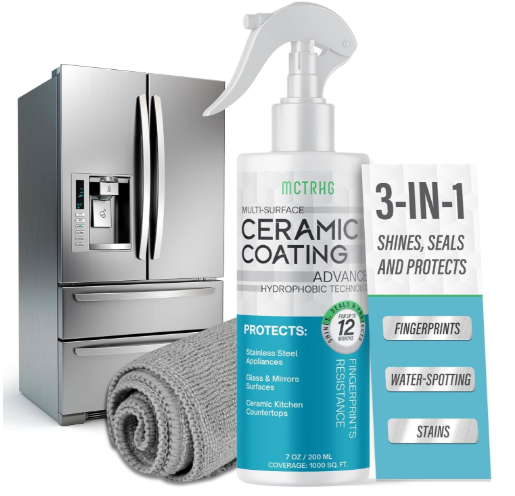
Description:
This is another spray-on ceramic/gloss/protection product designed to repel fingerprints, grime, water spots, and soap scum. It’s marketed as delivering a “super slick & shiny” finish with oleophobic (oil-repelling) properties. Its life expectancy in description is between 6-12 months depending on usage.
Key Features:
- High-gloss ceramic coating with hydrophobic + oleophobic behavior.
- Safe for multiple surfaces including stainless steel, sinks, faucets, glass, marble, etc.
- Sprays on, wipe off; includes cloth or recommends using microfiber for buffing.
Pros:
- Adds aesthetic shine as well as protection.
- Good multi-surface use → useful if you have many surfaces (not only stainless steel) you want to protect and unify in finish.
- Removes or reduces common surface issues like fingerprints or water staining.
Cons:
- Gloss finish may show smudges more visibly than matte surfaces; you might see streaks if not buffed properly.
- The claimed life span (6-12 months) may be optimistic for busy appliances like oven doors or refrigerators with handles.
- Some reports by users of uneven finish or residue if not properly buffed or if spray mists land in corners and cracks.
Recommendation:
A nice mid-tier choice for those who care both about appearance and protection. Particularly good for stainless steel in kitchens where fingerprint smudges kill the look. Recommendation: apply in a low-dust environment, buff thoroughly, reapply every ~6 months or when you notice it losing effect.
4. Home Ceramic Coating Spray Kit – 12 oz Durabasics (Kitchen & Bath)
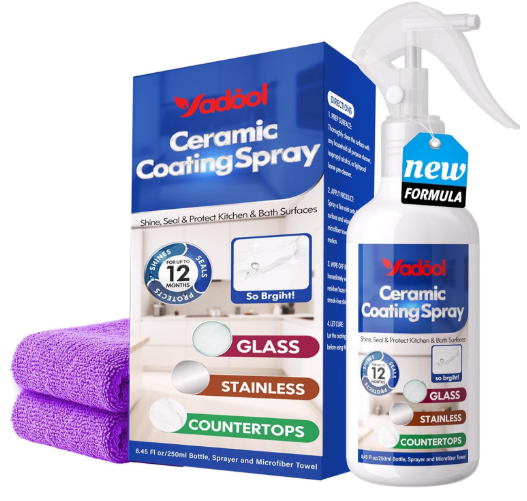
Description:
This 12-oz kit by Durabasics is a larger spray package that comes with instructions and a microfiber cloth. It’s designed for kitchen and bathroom surfaces, including stainless steel, and promises to seal, shine, and protect surfaces against fingerprints, grime, and stains. It emphasizes ease of use and includes safety features like a spray lock.
Key Features:
- Large 12-oz bottle for more applications.
- Spray kit includes applicator cloth and safety-lock sprayer.
- Versatile across many surfaces: countertops, stainless steel, sinks, glass, etc.
- Provides superior shine and seal. Repels fingerprints and grime.
Pros:
- Good value for quantity — 12 oz means more coverage for more appliances or surfaces.
- Safety lock on the sprayer helps avoid accidental sprays.
- Easy to use, especially for first-timers with the included cloth and instructions.
- High shine finish enhances appearance greatly.
Cons:
- Because of high gloss, fingerprints or dust may stand out more if the coating starts to wear.
- Might require frequent applications in areas where surfaces are handled daily.
- Be careful not to over-spray or allow glaze buildup; residual haze can appear if buffing is not thorough.
Recommendation:
This is a great pick if you have multiple stainless steel surfaces (stove, fridge, dishwasher) and want one product that can cover them. The lock sprayer and included cloth make it user-friendly. Good choice if you’re willing to maintain it (reapply when needed) to keep that “just polished” look.
Comparison: What We Can Learn
Here’s a quick comparison table summarizing strengths & trade-offs:
| Product | Duration Claim | Gloss / Shine | Ease of Application | Best For |
|---|---|---|---|---|
| Surface Lock Home (Berkland) | Several months | Moderate satin / smooth | Very easy spray & buff | Appliances, fingerprint heavy surfaces |
| Lifeproof Home | ~6-12 mos | High gloss / glass-like feel | Very easy, includes cloth/towel | Multi-surface protection, aesthetics |
| MCTRHG | 6-12 mos | Very glossy, mirror-like shine | Spray & buff; sensitive to prep | Those wanting shine + protection combo |
| Durabasics 12 oz Kit | Frequent reapplication if heavy use | Very glossy finish | Good with safety spray, more quantity | Covering many surfaces, larger areas |
Note: Products I Couldn’t Find Full Details For
I found 4 strong candidates; others had claims but not enough reliable specs (e.g. heat resistance, food safety if near cooking zones). Thus I didn’t include those to keep quality high.
How to Use Ceramic Coating on Stainless Steel
Step 1: Prepare the Surface
- Clean thoroughly: Use a stainless steel cleaner or mild soap and water to remove grease, dirt, and fingerprints.
- Dry completely: Ensure no moisture is left, as water can prevent the ceramic coating from bonding.
- De-grease if needed: For heavily used kitchen surfaces, a degreaser (alcohol-based cleaner) helps the coating adhere better.
Step 2: Apply the Ceramic Coating
- Shake the bottle well to evenly mix the formula.
- Spray or apply with an applicator (depending on the product). Usually, a fine mist directly on the surface or onto a microfiber cloth works best.
- Spread evenly: Use a microfiber cloth to spread the coating in straight, overlapping motions. Avoid circular “buffing” until the layer is uniform.
Step 3: Allow to Bond
- Let the coating sit for a few seconds to a few minutes (check instructions on the product). This helps it bond with the stainless steel surface.
- Buff gently with a clean microfiber cloth until the surface looks streak-free, shiny, and smooth.
Step 4: Cure Time
- Some coatings require a curing period of a few hours to overnight before the surface is exposed to water, cooking, or heavy use.
- During this time, avoid touching or cleaning the coated surface.
Step 5: Maintenance
- Clean gently using mild soap and water or a non-abrasive stainless steel cleaner.
- Avoid scrubbing with steel wool or harsh pads, which can wear down the ceramic layer faster.
- Reapply every 3–12 months, depending on the product and how often the surface is used.
Safety Guide for Using Ceramic Coating on Stainless Steel
1. Work in a Well-Ventilated Area
Some coatings may release mild fumes during application. Open windows, use fans, or work outdoors when possible.
2. Wear Gloves
Ceramic coatings contain chemicals that can irritate skin. Nitrile or latex gloves prevent direct contact.
3. Protect Eyes & Airways
Avoid spraying into the air near your face. If you’re sensitive, wear safety glasses and a light mask.
4. Keep Away from Food During Application
Do not spray directly near food or unwashed cookware. Always allow the coating to fully cure before cooking on or near treated cookware.
5. Avoid Over-Application
Using too much product can leave streaks, haze, or sticky residue. A light, even coat is better.
6. Store Safely
Keep ceramic coating bottles sealed tightly, away from heat sources and direct sunlight. Store out of reach of children and pets.
7. Heat Considerations (Cookware)
If applying ceramic coating on cookware (pots, pans, stainless steel baking sheet
Frequently Asked Questions (FAQs)
1. Can I use ceramic coating meant for cars on my stainless steel appliances?
Yes, many automotive-grade ceramic coatings can technically bond with stainless steel. However, they are not always food-safe and may be overkill for home use. For kitchen appliances and cookware, it’s best to choose a home or food-safe ceramic coating specifically designed for stainless steel.
2. How long does ceramic coating last on stainless steel?
The durability depends on the product and how heavily the surface is used. On average, coatings last 3 to 12 months. For frequently touched appliances like refrigerators, you may need to reapply more often.
3. Is ceramic coating safe for cookware?
Yes — but only if the product is explicitly labeled as food-safe and heat-resistant. Some coatings are intended only for appliances or surfaces, not for pots and pans. Always check the manufacturer’s recommendations.
4. Will ceramic coating stop scratches on stainless steel?
Ceramic coating provides a thin, protective barrier that reduces minor scratches and swirl marks, but it won’t prevent deep scratches from sharp or heavy objects. Handle cookware and appliances with care even after coating.
5. Do I need to reapply ceramic coating after cleaning?
No, not after every cleaning. If you use mild soap and water, the coating remains intact. However, abrasive scrubbing pads or harsh cleaners will wear it down faster, meaning reapplication may be necessary sooner.
6. Can ceramic coating make stainless steel completely fingerprint-proof?
Not completely. It significantly reduces smudges and fingerprints by creating a slick surface, but high-traffic appliances may still show light marks. The difference, though, is that they wipe off much more easily.
Conclusion
Stainless steel is stylish, strong, and timeless — but it does have one weakness: smudges, water spots, and sometimes difficult cleanup. That’s where ceramic coatings step in as a game-changer. By applying a high-quality ceramic layer, you create a protective shield that enhances shine, repels grime, and extends the lifespan of your cookware, appliances, or even automotive stainless steel parts.
From easy-to-apply spray coatings like Surface Lock and Durabasics, to longer-lasting premium options like Lifeproof, there are solutions for every need and budget. The key is to choose a food-safe, heat-resistant formula if you’re coating cookware, and a durable, fingerprint-resistant option if you’re focusing on appliances.
When applied correctly, ceramic coating not only makes stainless steel look new for longer but also saves you time on maintenance. For homeowners, chefs, or anyone who wants a sleek, low-maintenance kitchen, investing in the best ceramic coating for stainless steel is absolutely worth it.